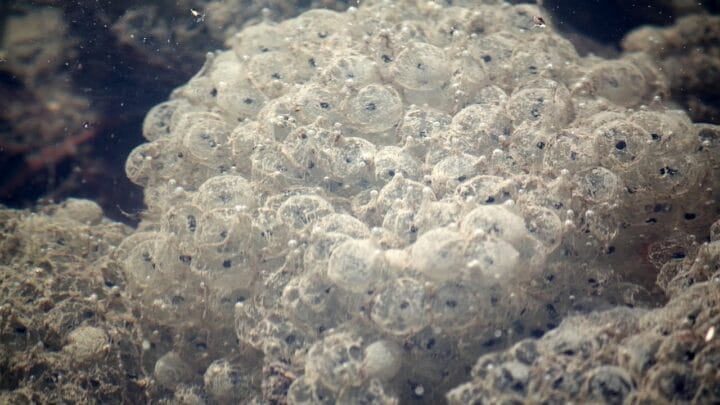Frogs are amphibians. This means that a frog’s skin should remain moist all the time.
If a frog’s skin is not moist, they are unable to breathe. This is why you usually find frogs near sources of water and in humid climates.
From the very beginning, a frog’s life revolves around water. They hatch from eggs that are developed beneath the surface or in damp areas cased in moisture.
What Do Frog Eggs Look Like?
Frogs spawn refers to the eggs in gel-like sacks that provide moisture. These take the form of either a large blob or a spread-out flat grouping mat. Within the frogspawn, the eggs are circular and see-through.
Appearance Of Frog Eggs
So what do frogs eggs look like? The appearance of frog eggs can seem a little ‘other-worldly’.
Some people relate the appearance of frog eggs to clusters of grapes.
Frog eggs do vary from species to species, but the overall appearance of the egg itself is the same. The embryo of the egg is black and can be seen through the egg mass.
The egg mass can either be clear, a slightly milky color, or have a hint of green to it.
The egg mass provides an extra layer of protection for the eggs. As the eggs continue their development, you can see the tadpole as it forms inside.
The eggs are completely encased in a gel-like sack, grid, or strand. The gel serves many purposes; it keeps the frogspawn together and protects the eggs from drying out.
The eggs can be found in different locations from species to species. When looking for frogspawn, you may come across it in many different fashions.
This could include gel-like sacs below shallow water, floating on the surface, or kept in place by plants.
As frogs are very social, oftentimes you can come across large groupings of frogspawn in one area.
How Frogs Release Eggs
The frogs’ breeding season begins after hibernation. The female frog has been developing eggs constantly.
When they find a mate, the male frog will get onto the female frog’s back and tightly wrap his arms around her. This in turn causes pressure and the female frog releases the eggs that have matured.
The male frog then fertilizes them immediately.
The eggs are enveloped by a gel-like substance. Together, this is referred to as frogspawn.
If the eggs are released into water, the frogspawn will sink to the bottom until it absorbs enough moisture to float.
How Frog Eggs Are Protected
Frog eggs need constant moisture if there is any hope of survival. Frogs that have their eggs in the water further ensure that the eggs will not dry out by creating the gel-like frogspawn.
This absorbs water and keeps the eggs contained.
However, not all frogs release their eggs into the water. Some frog species have their eggs on land.
Since the eggs do not possess a shell, they’re defenseless against the elements.
There are species of frogs that ‘carry’ their eggs with them. Eggs can be visible on the backs of some frog species.
While others take a very different approach and the male carries the eggs in his throat until the time when they begin to hatch.
In places like the rainforest where there are many species of treefrogs, their eggs can be found in damp clusters of leaves above the water.
Once the tadpoles emerge from the eggs, they fall from the trees directly into the water beneath where they continue their growth.
When it comes to protecting frog eggs from potential predators, adult frogs do not watch over them. However, that’s where the placement of the frog spawn comes into play.
Frogs look for sheltered areas that are secluded. Both frogs that release their eggs in water and on land, look for dense plant life that can protect the eggs from view.
In areas of high prey, the method of having their eggs in a grid-like frogspawn gives them a higher chance that a predator might snatch a few, but the rest will survive.
Frequently Asked Questions About What Frog Eggs Look Like
How do you tell the difference between frog eggs and other types of amphibians?
Frog eggs are unique in the shape of the outer protective layer that holds their eggs in a cluster. Many other amphibians, such as toads, have eggs that they release in long strands.
How many eggs do frogs have?
While the frog species play a significant role in this country, they can release anywhere between 2,000 to 20,000 eggs at a time.
If I have frog eggs in my pond, can I safely move them?
While it is possible to move frogspawn, it is not recommended as you can damage it. If it is necessary, put it into a large bucket of water and let it remain there until the frogspawn hatches into tadpoles. They can then be relocated.
In Conclusion
The appearance of the frog egg is unique. Both the method in which they incase their eggs in the gel-like sack and the fact that the eggs themselves are clear, are not something you see frequently.
While they may look other-worldly, the protective gel and egg mass execute the job of keeping the frogspawn safe until they are ready to hatch.


